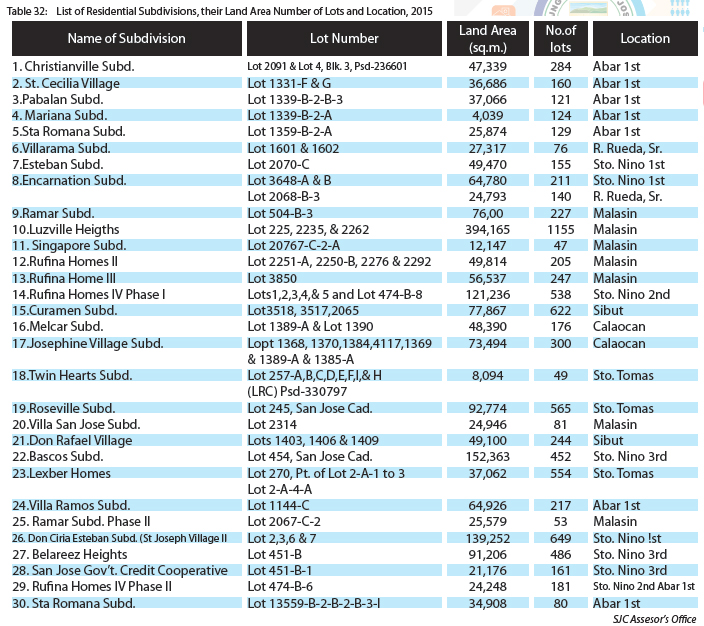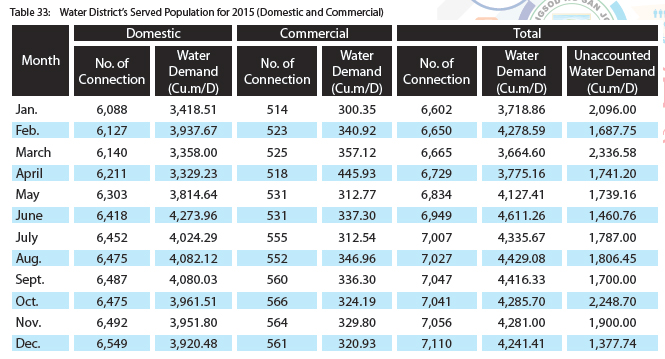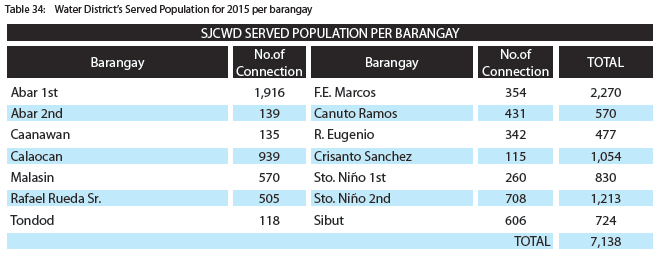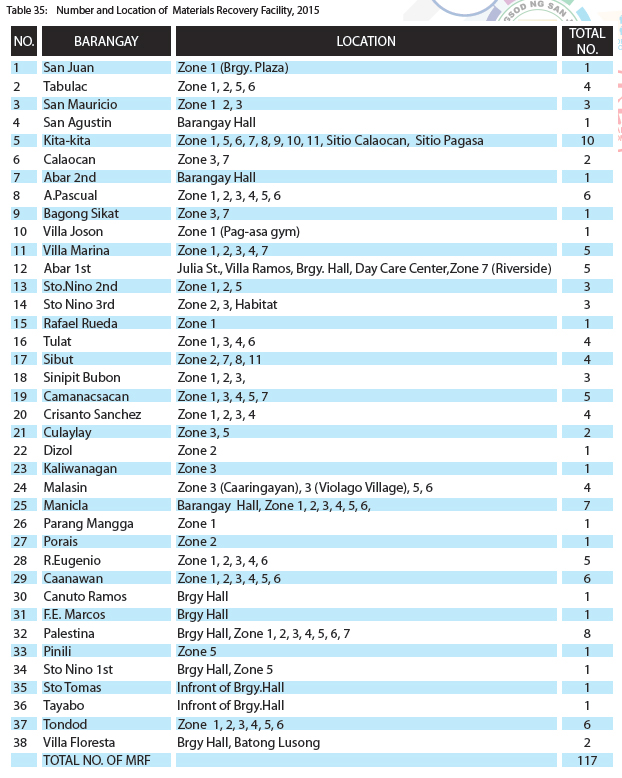Present Status of Well Being »
Housing
Published: May 16, 2023 12:44 PM | Author: CPDO 2015
The increasing population of the city increases the demands on housing requirements for its constituents. This activity is being undertaken by private sectors that took the initiatives to develop idle and unproductive lands into residential areas. The trend of the on-going residential area developments is the path going to Manila, Nueva Vizcaya and Pangasinan. Most of these developments are in the outskirts of the city proper and these are in accordance with the existing zoning ordinance and land use plan of the city.
At present there are several completed and on-going subdivision developments (private) (See Table 32), which will accommodate to the housing needs of the city.
The LGU sees the need for these housing demands and to alleviate the housing condition of some citizens of San Jose City, some housing projects were launched in coordination with line agencies in the national level. The ASB (Ariin Sariling Bakuran ) was one, another was the Habitat for Humanity Housing . Both are located in Barangay Sto Nino 3rd.
At present ASB housing project serves as home to a 465 houses in around 511 households. The units in ASB are single units and the materials used varries from concrete, semi concrete to wooden or sawali . The number of families in a unit is one depending on the lot size. Their tenure on the lots is in10 years to pay scheme.
There are around 121 houses and the same number of household in HABITAT for Humanity. In Habitat for Humanity, the houses are duplex and made of concrete materials. The number of families per unit is single and the house are duplex type. Their tenure on the house is ten (10) years to pay while homelot ownership is twenty five years (25) to pay scheme.
Another housing project which benefits some of our moderate earner employees is a joint project of the National Housing Authority and the Local Government Unit tied up with the District II House of Representatives. The project is in a 1.5 hectare located at Barangay Palestina now housing 32 families in original scheme of house and lot plus 6 own built houses. The mode of payment is 30 years to pay both in house and lot and in lot only availments.
A. Residential Subdivisions, their Land Area Number of Lots and Location.
(see table 32)
B. Sources of Drinking Water
The San Jose City Water District, having a technical cooperation and supervision with the Local Water Utilities Administration (LWUA) supplies the potable water needs of the city. It has an existing water supply system, which serves 14 barangays of the city with a total of 7,138 service connections as of December 2015, serving 6,549 domestic connections (91.74%) and 561 commercial or 7.85% connections. Table 33 shows the served population from January to December 2015.
(see table 33 and 34)
Although 14 of the 38 barangays in the city are being served by the San Jose City Water District, a large percent of households especially in the rural areas are relying on jetmatic water pumps or manual water pumps. Studies have shown during tests on water samples that large portion of waters in the remote areas or rural barangays especially those that are located at the mountainous side of the city are safe for drinking.
C. Garbage Disposal
The city is presently studying on the feasibility of establishing an engineered Sanitary Land Fill. The documents needed for the transfer of ownership of the identified site which is at Barangay Villa Joson is on process. The site however is subject to inspection by the EMB after it has already been inspected by the Mines and GeoSciences Bureau. Currently, the local government is operating on a large scale scheme on solid waste management hauling in an average of thrice a week. Solid Wastes are being taken in by a rotation of schedules of dump trucks managed by the local goverment and is being placed into an area in barangay Sto. Tomas in which they are hauled by the Clark Sanitary Landfill. The hauling schme is under a Memorandum of Agreement with the city government which would end by December 2106. The average volume of being hauled is 1,100 cubic meters per month , roughly 36-40 cubic meters per day which costs P550.00 per cubic meter . On other wastes, the city has a total of 117 Material Recovery Facility all over the rural and urban barangays of the city. As shown in table 27 some barangays have more than one Material Recovery Facility in their respective barangay.
Is has been the program of the city government which is in the run for several years to date, to call for support to the households through meetings, official letters that the biodegable wastes like leaves, grasses are to be left to the responsible owners to bury or compost in their open areas.
The city is implementing the three Rs on solid wastes; the Reduce, Re-use and Re-cycle. The recycling system has been in implementation by the local unit on plastic products. The “palit basura” program was launched a few years back, focusing on sorted plastics which are being exchanged for items including soaps, toothpaste, umbrellas,
bags or book or any small household item. Collated plastics were being shredded into a small pieces to make another useful item like toys, pillows and the like. Leaves shredding is also being ran with the participation of all barangays and some of the public elementary schools. Barangay Captains and School Principals/Heads are tapped to implement this project.
Toxic wastes like funeral wastes are being disposed of in septic tanks. Hospital wastes are disposed likewise in septic vaults/tanks or hauled by an accredited hauler. Other special wastes ( from food chains, dressing plants, etc.) are also being hauled by accredited haulers.
(see table 35)




